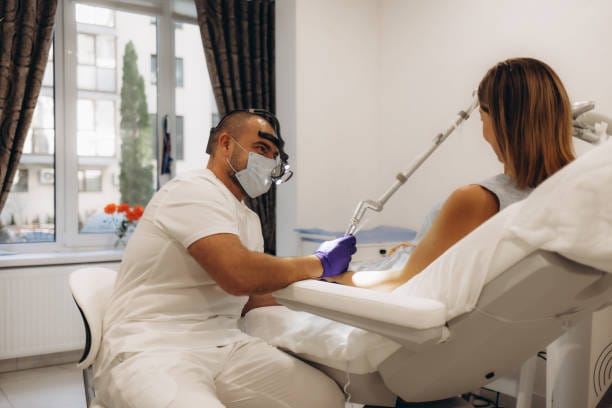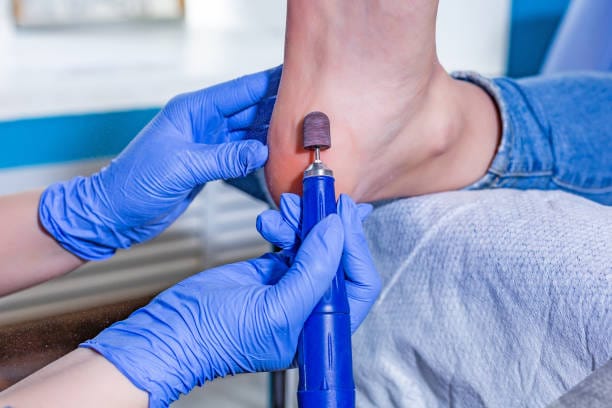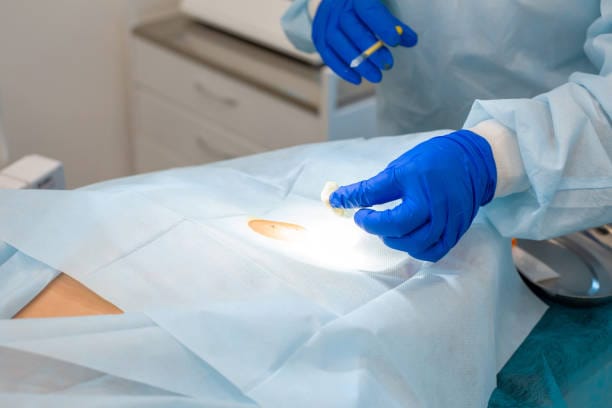
Human papillomavirus (HPV) causes verrucas, small rough growths on the feet. Although some disappear without treatment, others become persistent, spreading or becoming painful and needing professional treatment. Many try over-the-counter remedies, but they do not always work, particularly with deep or stubborn verrucas.
It is best to use the service when you are in the best position to prevent these verruca treatments so you don’t hurt yourself by delaying treatment; you cannot avoid further complications or discomfort. If you begin to feel pain, see it spreading, or if it does not respond to treatment at home, you can consult a specialist. Scarring or recurrence can be prevented if treatment is given early because the Disease will respond faster, and scarring can be reduced.
What Are Verrucas?
Plantar warts (verrucas) are caused by the human papillomavirus (HPV). This virus infects the skin through small cuts or breaks, forming small, rough, and even painful growths. Most verrucas occur on the soles of the feet, particularly on the low or heel and balls of the feet.
How to Identify a Verruca
- Verrucas usually look rough, grained or cauliflower-like with a hard surface.
- They may not be coloured or look skin coloured, white, or lightly yellow, with very small black dots (clots of blood vessels) inside.
- Worse, unlike regular warts, verrucas can be painful when walking or standing as this pressure pushes them deeper into the skin.
- Mosaic warts: Several isolated verrucas may form clusters (mosaic warts).
How Verrucas Spread
HPV is very contagious and is transmitted directly or indirectly. You can catch verrucas by:
- Walking in places like swimming pools, gyms, and communal showers barefoot.
- Touching objects that an contaminated person has used, such as a used towel or sock.
- Spreading the verruca by touching it and then touching another part of your body.
Verruca vs. Other Skin Growths
Many people mistake a verruca for a corn or callus, but corns and calluses do not affect the normal skin pattern, while a verruca does. A verruca is a round growth that, unlike corn, may have black dots and be sore when pressed from the sides.
Some verrucas resolve themselves, but painful, stubborn, or aggressive spreading verrucas often require professional treatment.
Signs That You Should Seek Verruca Treatment
Although not all verrucas need medical assistance, professional verruca treatment may be required if signs reveal this may be necessary. Failure to recognise these signs can be followed by extreme discomfort, spread of the problem, or complications. Here’s when to seek help:

1. Persistent or Non-Healing Verrucas
Verrucas may clear within a few months or years, but some can persist longer despite home treatments. If a verruca persists or grows after six weeks of treatment, it is time to see a specialist.
2. Pain or Discomfort When Walking
Sharp pain when walking or standing can occur if verrucas are present on the weight-bearing parts of the feet (heels or balls of the feet). Pressure causes them to go deeper into the skin, making them more difficult to treat at home.
3. Spreading Verrucas or Clusters
A verruca spreads if it multiplies into a cluster (mosaic warts) or starts appearing in other areas. Early treatment will prevent the spread of verruca and make its removal easier.
4. Bleeding, Inflammation, or Disease
An contaminated verruca bleeds, changes colour or appears inflamed. Disease signs include:
- Redness and swelling of your skin around the verruca.
- Pus or unusual discharge.
- Increased pain or warmth in the affected area.
- An contaminated verruca must be treated urgently to avoid problems in future.
5. Compromised Immune System
Do not attempt to self-treat if you have diabetes, poor circulation, or weakened immunity (such as due to HIV or from immunosuppressive medications). Just as a verruca can lead to serious foot complications, it is best to consult a professional as soon as possible.
6. Verruca in a Sensitive Area
If a verruca arises on the face, genitals, or other delicate part, professional treatment is required to prevent scarring or irritation.
If you see some of these signs, professional verruca treatment can help with recovery time, alleviate some discomfort, and avoid complications.
Why Over-the-Counter Treatments May Not Work
Many people try a course of over-the-counter (OTC) verruca treatments before they consider seeking professional care. In this case, these methods may work for surface-level verrucas but will not effectively address the robust, enduring or recurring verrucas. We wanted to share the reasons why OTC treatments may not be effective, here’s why:
1. Salicylic Acid Takes Too Long or Fails to Work
Salicylic acid is one of the most commonly used verruca treatments as it can help to break down the layers of thickened skin. However:
It should be used regularly for weeks or months before its supposed results can be seen.
Some verrucas do not decrease even after prolonged treatment, so they become resistant.
It can be misused and fire and damage healthy skin, resulting in pain and irritation.
2. At-Home Cryotherapy Is Too Weak
Freezing, cryotherapy, is popular, but home freezing kits are not as powerful as medical-grade liquid nitrogen.
Professional cryotherapy reaches -196°C, while home kits freeze verrucas at -50°C, making it far more effective.
Because the verruca is never fully frozen, the result may be incomplete freezing, leading to regrowth.
The surrounding skin can be damaged despite repeated applications, yet the verruca’s root is not eliminated.
3. OTC Treatment Is Not Enough
Although an OTC treatment may reduce one verruca, this doesn’t necessarily mean you got rid of the virus. Due to the virus still being alive in the skin, you can develop verrucas in the same area. Verrucas can spread to other areas of the foot or even the hands.
4. Home Remedies Are Unreliable and Risky
Verrucas can be removed using duct tape, vinegar, garlic or banana peels, but there is little scientific proof that they work. Instead, they can:
- It can cause burns, irritation of the skin or Disease.
- Do not penetrate to the verruca’s deep layers, resulting in recurrence.
If the standard OTC (over-the-counter) treatments are not working, professional verruca removal will provide faster, safer, and more reliable results.
When to See a Doctor for Verruca Treatment
Home remedies will help if you have a verruca that is not looking to improve or is causing discomfort; however, sometimes, your verruca will require professional treatment.

1. When Home Treatments Fail
Verruca over-the-counter treatments are known to work, but it may take weeks or months to see an effect. However, if you notice that your verruca gets worse or stays exactly as it is after 4–6 weeks of treatment, your verruca may need professional removal.
2. If the Verruca Is Painful
When verrucas occur on weight-bearing parts of the feet, such as the heels or balls, they go deep into the skin and can be excruciatingly painful to walk on. If your verruca is impairing your daily activities, professional treatment can relieve the pain.
3. When Verrucas Multiply or Spread
Verrucas tend to disseminate quickly, and clusters (mosaic warts) can occur or appear on other parts of the foot. A specialist can help prevent the further spread of the virus and control the new verrucas as they form.
4. If the Verruca Is Bleeding or contaminated
Verruca that require medical attention immediately include :
- Bleeds frequently without injury.
- If blood is brought to the wound, it will become red, swollen, or filled with pus, evidence of Disease.
- The urine seems warm or very painful, which may indicate that it is a bacterial Disease.
5. If You Have a Weakened Immune System
Home treatments are not suggested for people who have diabetes, poor circulation, or immune disorders. Untreated, a verruca could develop into a serious foot complication.
6. If the Verruca Is in a Delicate Area
Any verrucae on your face, hands, genitals, etc., which are sensitive areas, should always be treated by a professional to avoid scarring or irritation.
Why Professional Treatment Is Better
Seeing a specialist ensures:
✔ Faster and more effective verruca removal
✔ Scarring or Disease will have a lower risk.
✔ The chance of verruca recurrence or spreading is less.
If you are one of those, having professional verruca treatment is your best and most secure bet.
Professional Verruca Treatment Options
Professional removal is faster and more effective if your treatment has not improved the verruca. The type of treatment the clinics offer varies by the verruca’s size, depth, and severity. The most common options are as follows.
1. Cryotherapy (Freezing the Verruca)
One of the most popular verruca removal treatments performed is cryotherapy. The verruca is frozen and destroyed by a specialist who directly applies liquid nitrogen (-196°C) to the contaminated skin cells.
✔ Quick procedure (5–10 minutes)
✔ Effective for stubborn verrucas
✔ May require multiple sessions
2. Laser Verruca Removal
Laser therapy aims to kill the verruca’s blood supply and so stop the verruca from growing. This is an especially good method for deep-rooted or resistant verrucas.
✔ Highly effective for persistent verrucas
✔ Reduces risk of recurrence
✔ Mild discomfort but minimal downtime
3. ElectroProcedure
The high-frequency electrical currents are used to burn off the verruca. This is a rapid and efficient way to eliminate big or sore verrucas.
✔ Instant verruca removal
✔ Performed under local anesthesia
✔ Short recovery time (few days)
4. Acid-Based Treatments
Chemically, the verruca is dissolved by stronger acids like Trichloroacetic Acid (TCA) in clinics. At least, these treatments reach deeper than salicylic acid and offer better results.
✔ Controlled application by a specialist
✔ Works well for smaller verrucas
✔ Requires several sessions
5. Needling
Falknor’s Needling is a technique that pierces the verruca several times to provoke an immune response that will enable the body to treat the virus.
✔ Good for multiple verrucas
✔ May remove verruca in one session
✔ Minimal downtime
Which Verruca Treatment Is Best?
The kind of treatment that will be best for the verruca depends on its size, site, and previous treatments. The most suitable approach will depend on what a consultation with a professional can tell.
Professional treatment of a verruca is safe. It removes the verruca, prevents it from spreading, and speeds up recovery.
What to Expect During Verruca Treatment
Knowing what to expect can ease nerves if you are considering professional verruca treatment. The procedure usually involves a consultation, an operation, and a short recovery time.
- Initial Consultation
Your specialist will determine the verruca size, depth and location to determine the best treatment.
- During the Verruca Removal Procedure
The treatment will determine exactly what the experience is. Freeze the agent for a few seconds. It’s usually quick, but it’s a cold, stinging sensation.
Treatment Options: The focused beam is aimed at the verruca, and some describe the sensation as a mild pinching or heat sensation.
ElectroProcedure is performed under local anaesthesia, so you do not feel any pain whatsoever. The dressing is applied, and the verruca is burned off.
A strong acid is applied to break down the layers of the verruca. The surface will feel slightly burning and tingling.
When the verruca is punctured, a numbing injection is given beforehand to increase the chance of the immune system working to fight the problem.
Most treatments take less than 30 minutes, and some might need multiple treatments to eliminate the telangiectasias.
- After the Procedure
Depending on your method, you may experience discomfort, redness, and swelling. If the treatment is Treatments, a protective dressing may be applied. The healing time varies: a few days for cryotherapy and laser therapy and 1–2 weeks for electroProcedure.
Your specialist will give aftercare instructions to protect you from recurrence and ensure proper healing. Call your clinic immediately if you feel pain, blood, or signs of Disease.
Understanding the process makes preparing for treatment and recovery easier, leading to better results.
How to Prevent Verrucas After Treatment
Once your verruca has been removed, you need to take precautions to prevent new ones from occurring. Since the human papillomavirus causes verrucas, they can recur if good foot care and hygiene are not maintained.
1. Keep Your Feet Clean and Dry
As the verruca-causing virus thrives in warm, moist environments, keeping your feet dry reduces the subsequent risk of Disease. Dip your feet daily in warm water, add soap, and then use for rinsing. Thoroughly dry them, especially between the toes. Change to new socks every day to avoid moisture build-up.
2. Do not Walk Barefoot in Public Areas
HPV is a virus, and hot spots are public places such as swimming pools, gyms, communal showers, or locker rooms. In these areas, you should wear flip-flop sandals or waterproof sandals. Do not share towels, socks or shoes with anyone.
3. Boost Your Immune System
A strong immune system will help fight viruses and thus reduce the chance of verruca recurrence. Consume a healthy diet containing vitamins, especially Vitamin C and Zinc. Remaining active is advised to improve circulation and immune response.
Sleep well and manage stress since being stressed out weakens immunity.
4. Don’t Pick at Healing Skin
Following verruca removal, your skin will begin to heal. Avoid:
- Do not pick at the scabs or peel the skin, as this can spread the virus.
- Foot scratching may introduce bacteria.
- Touching an contaminated nail area using the same nail clippers or pumice stone.
5. Disinfect Shoes and Socks
- This is to kill any remaining virus particles.
- Wash socks at high temperatures.
- It is also important to use antibacterial shoe sprays or UV light sanitisers.
- Shoes should always be aired between uses.
6. Check Your Feet Regularly
Check your feet for early signs of verrucas (small, rough patches of skin) and treat one early if one has grown.
Following these guidelines can decrease the chance of verrucas returning and maintaining healthy feet. If you see any suspicious skin changes, get a specialist trained immediately.
Why Choose Revitalise London for Verruca Treatment?
At Revitalise London, our verruca treatments are safe, effective, and advanced for you. Our clinic offers the latest solutions, such as cryotherapy, electroProcedure, tissue coagulation and laser therapy, that provide great results without the usual downside of pain and major bleeding. Our expert practitioners have a clinically proven technique to remove stubborn verrucas and an increased reduced risk of recurrence.
As body modification specialists, we emphasise patient comfort, cleanliness, and aftercare while assisting you. If you need a quick verruca treatment in London that requires long-term foot care, Revitalise London is your leading choice for professional verruca removal.
Take the first step towards clear, healthy skin; book your consultation today!
